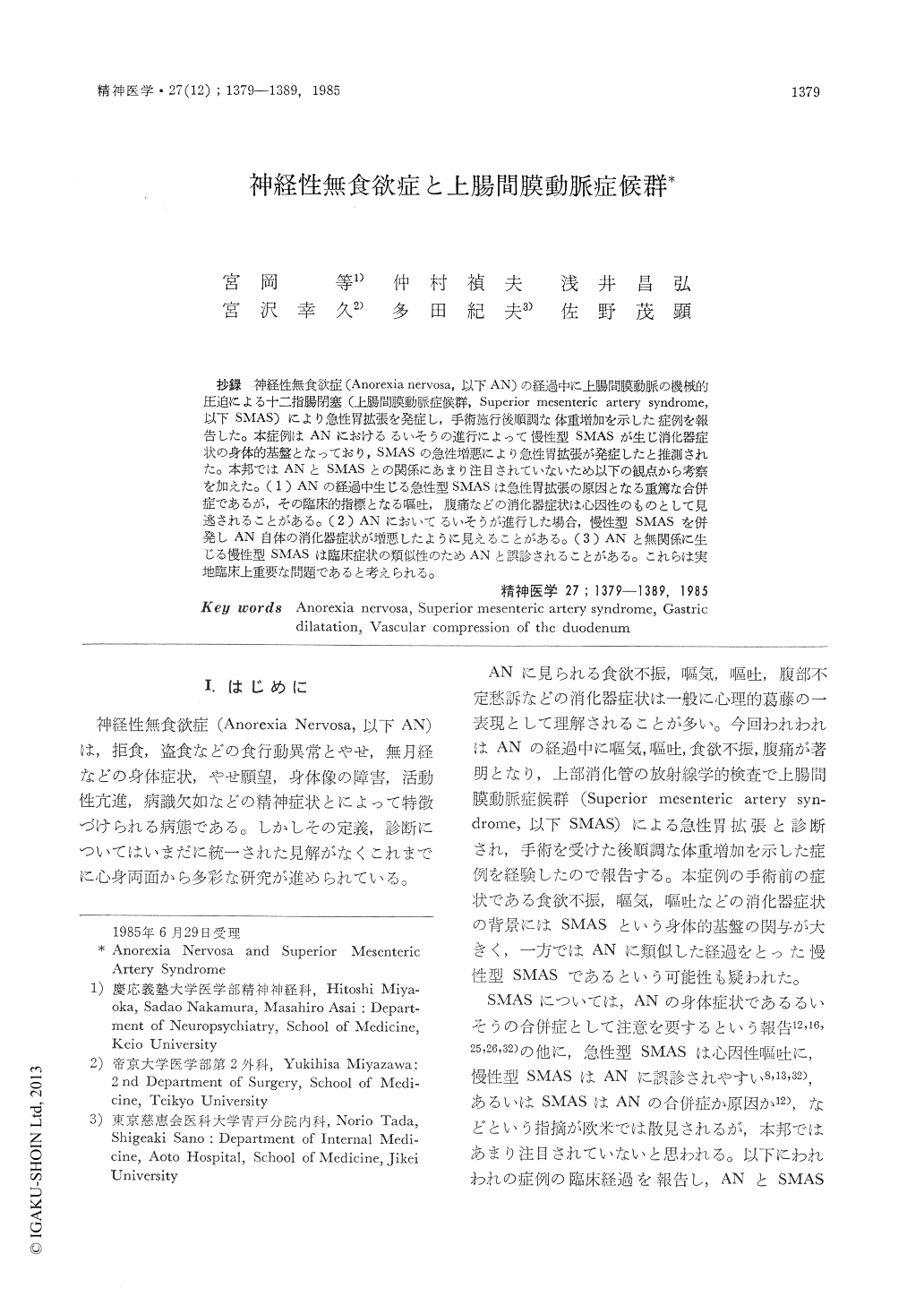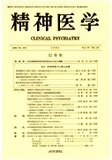Japanese
English
- 有料閲覧
- Abstract 文献概要
- 1ページ目 Look Inside
抄録 神経性無食欲症(Anorexia nervosa,以下AN)の経過中に上腸間膜動脈の機械的圧迫による十二指腸閉塞(上腸間膜動脈症候群,Superior mesenteric artery syndrome,以下SMAS)により急性胃拡張を発症し,手術施行後順調な体重増加を示した症例を報告した。本症例はANにおけるるいそうの進行によって慢性型SMASが生じ消化器症状の身体的基盤となっており,SMASの急性増悪により急性胃拡張が発症したと推測された。本邦ではANとSMASとの関係にあまり注目されていないため以下の観点から考察を加えた。(1)ANの経過中生じる急性型SMASは急性胃拡張の原因となる重篤な合併症であるが,その臨床的指標となる嘔吐,腹痛などの消化器症状は心因性のものとして見逃されることがある。(2)ANにおいてるいそうが進行した場合,慢性型SMASを併発しAN自体の消化器症状が増悪したように見えることがある。(3)ANと無関係に生じる慢性型SMASは臨床症状の類似性のためANと誤診されることがある。これらは実地臨床上重要な問題であると考えられる。
Superior mesenteric artery syndrome (SMAS) is the condition caused by delay in the passage of intestinal contents beyond the third portion of the duodenum, due to compression of this part against the spine by the superior mesenteric artery. Two subtypes, acute and chronic, are recognized. The acute syndrome occurs in immobilized supine padents who have lost weight rapidly as in a systemic disease. The presenting symptoms which develop suddenly are those of acute obstruction of the small bowel. The chronic SMAS usually occurs in patients of the habitus asthenicus and is characterized by intermittent abdominal pain, bloating, anorexia, nausea and vomiting. Most of the patients learn to limit food intake or may become phobic to eating.
Anorectic patients who have had a rapid weight loss may develop the acute form of SMAS. Physical symptoms of acute SMAS may be mistaken for psychogenic vomiting in anorexia nervosa (AN) though they are severe complications, which may often lead to death. Chronic SMAS sometimes occurs in anorectic patients and worsens gastrointestinal symptoms of AN itself. Although AN may cause chronic SMAS as its complication, pure chronic SMAS itself may be misdiagnosed as AN because of the similarity of the symptoms of AN and SMAS.
A 15-year-old girl developed anorexia and amenorrhea 4 months after entrance into a high school. Her weight had fallen from 44kg to 30kg (43.6% below ideal weight) for 6 months. She was diagnosed as AN. One year after the onset of AN she began to complain post prandial nausea, vomiting and intermittent abdominal pain. Two years after the onset acute gastric dilatation developed. Her weight was 39kg (36.1% below ideal weight). A barium meal X-ray examination and abdominal ultrasonography revealed obstruction of the third portion of the duodenum at the level of the superior mesenteric artery. The diagnosis of arterio-mesenteric occlusion of the duodenum (superior mesenteric artery syndrome) was confirmed. An operation (translocation of the duodenum) was performed. Over 7 months postoperatively she gained 10 kg and recovered to her premorbid body weight. Two years and 8 months after the operation she weighed 60kg (12.8% above ideal weight) and has been free of the symptoms of AN.
In this case the authors speculate that rapid loss of weight resulting from AN caused chronic SMAS as a complication of AN when postprandial gastrointestinal symptoms became worse. Acute deterioration of SMAS occurred and acute gastric dilatation developed. Disappearance of AN symptoms after the surgical operation can be related to the fact that AN is often recovered after surgical procedures such as laparotomy, tonsilectomy and appendectomy SMAS needs to be considered in the diagnosis and treatment for AN in that : 1) acute SMAS is a severe complication of AN but its symptoms may be often misdiagnosed as psychogenic, 2) chronic SMAS resulting from emaciation in AN worsensgastrointestinal symptoms of AN itself, and 3) pure chronic SMAS may be misdiagnosed as AN because of the similarity of the symptoms.

Copyright © 1985, Igaku-Shoin Ltd. All rights reserved.


